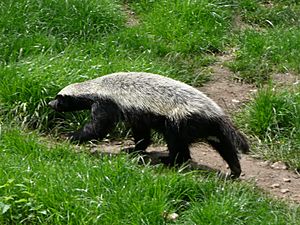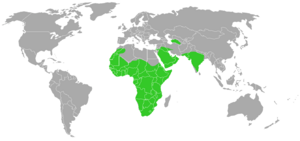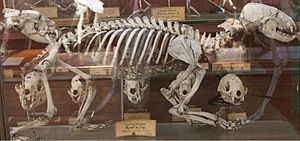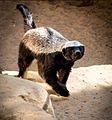Honey badger facts for kids
Quick facts for kids Honey badgerTemporal range: middle Pliocene – Recent
|
|
|---|---|
 |
|
| Conservation status | |
| Scientific classification | |
| Genus: |
Mellivora
|
| Species: |
capensis
|
 |
|
| Distribution | |
The honey badger (also called ratel) is a tough animal. It's part of the weasel family. You can find it in Africa, the Middle East, and parts of Asia.
Even though it's called a badger, it looks more like a large weasel. Honey badgers mostly eat meat. They don't have many enemies because of their thick skin and amazing fighting skills.
Contents
What is a Honey Badger?
The honey badger is the only animal in its group, called Mellivora. Even though it was once thought to be a type of badger, it's actually more closely related to martens.
Physical Features
Honey badgers have long, strong bodies. Their skin is loose, which helps them twist and turn easily when fighting. The skin around their neck is about 6 mm (0.24 inches) thick. This thick skin helps protect them during fights.
Their head is small and flat, with a short nose. Their eyes are small, and their ears are tiny bumps on their skin. These small features also help them avoid injury when they are fighting.
Honey badgers have short, strong legs with five toes on each foot. Their claws are very powerful. The claws on their front feet are much longer than the ones on their back feet. They use these claws for digging.
Adult honey badgers are usually 23 to 28 cm (9 to 11 inches) tall at the shoulder. Their body length is about 68 to 75 cm (27 to 30 inches). Males are bigger than females. Males weigh about 12 to 16 kg (26 to 35 pounds), while females weigh around 9.1 kg (20 pounds).
Honey badgers have a special scent gland near their tail. The smell from this gland is very strong. Some people think this smell might help calm bees when the badger raids a beehive.
Fur Color
Honey badgers have unique fur. The sides of their heads and their lower bodies are pure black. A wide white band covers their upper bodies. This band starts at the top of their heads and goes all the way down to the base of their tails.
Habits and Behavior
Honey badgers usually live alone. They dig their own homes, called burrows. They are excellent diggers and can dig tunnels in hard ground in just 10 minutes! Their burrows are usually simple, with one entrance and a small nesting room. They don't put any bedding in their nests. Sometimes, they will use old holes dug by aardvarks or warthogs, or even termite mounds.
Honey badgers are very smart animals. They are one of the few animal species known to use tools. In a nature show from 1997, a honey badger in India was filmed using a log. It rolled the log and stood on it to reach a bird stuck in roots inside an underground cave.
Honey badgers are known for being fearless and tough. They will bravely attack enemies if they can't escape. They are tireless fighters and can wear out much larger animals. Some scientists believe that cheetah kittens have fur that looks like a honey badger's. This might be a way to scare off predators, making them think the kittens are tough honey badgers. This is called mimicry.
Honey badgers make a hoarse "khrya-ya-ya-ya" sound. When they are mating, males make loud grunting noises. Baby honey badgers make whining sounds. If dogs attack a honey badger, it might scream like a bear cub.
What Honey Badgers Eat
Honey badgers are not picky eaters. They will hunt at any time of day in quiet areas. But in places with many people, they become active at night. When they hunt, they trot along with their front toes turned inward.
Despite their name, honey badgers mostly eat meat. They will eat almost any animal food they can find. This includes dead animals, small rodents, birds, eggs, insects, lizards, tortoises, and frogs. They also eat some fruits and vegetables like berries, roots, and bulbs.
They can dig up frogs and rodents like gerbils and ground squirrels from their burrows. Honey badgers can easily eat tortoises because of their strong jaws. They also hunt and eat snakes, even very poisonous or large ones. They eat all parts of their prey, including skin, fur, feathers, meat, and bones. They hold their food down with their front paws. When looking for plants to eat, they might lift stones or tear bark from trees.
Where They Live
Honey badgers can be found in most of Sub-Saharan Africa, from South Africa up to southern Morocco and southwestern Algeria. Outside of Africa, they live across the Arabian Peninsula, Iran, western Asia, Turkmenistan, and the Indian subcontinent.
Honey Badgers and Humans
Honey badgers sometimes kill chickens that people are raising. Because they are so strong and determined, it's hard to keep them away. They are known to rip thick wooden planks from chicken coops or dig tunnels under stone walls.
It's very hard to kill honey badgers with dogs because of their tough, loose skin. Their skin is difficult to bite through. The loose skin also lets them twist and turn to fight back even when they are held. The only safe way to hold a honey badger is by the back of its neck. Their skin is also tough enough to resist several hits from a machete. The quickest way to kill them is with a strong blow to the head or a shot from a powerful rifle. Their skin is almost impossible to pierce with arrows or spears.
Images for kids
See also
 In Spanish: Ratel para niños
In Spanish: Ratel para niños









